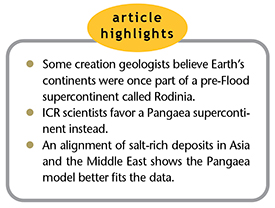 Debate exists over the pre-Flood continental configuration, with some creation scientists advocating for an initial supercontinent called Rodinia centered at the South Pole.1 ICR scientists, however, use a slightly modified Pangaea centered at the equator. It has the most empirical geological evidence supporting it and provides the best-fit reconfiguration of the modern continents.2
Debate exists over the pre-Flood continental configuration, with some creation scientists advocating for an initial supercontinent called Rodinia centered at the South Pole.1 ICR scientists, however, use a slightly modified Pangaea centered at the equator. It has the most empirical geological evidence supporting it and provides the best-fit reconfiguration of the modern continents.2
ICR researchers recently examined some unusual Late Precambrian salt-rich rocks in Asia and the Middle East. We think these deposits originated from the earliest days of the Flood, forming about 4,400 years ago during the bursting of the fountains of the great deep (Genesis 7:11). The deposits are found across the Middle East, Pakistan, and India, and are often thousands of feet thick. They extend from the Persian Gulf (Hormuz Evaporates) to Pakistan (Salt Range Formation) to western India (Hanseran Evaporates)3-5 and have been conventionally dated as Late Precambrian, about the same date as Rodinia.6
Finding thick salt-rich layers in rocks prior to the Cambrian is unusual. Since secular geologists claim these rocks are the same age as Rodinia, we can use their extent to test the validity of the Rodinia reconstruction. Figure 1 shows the current extent of the salt-rich layers across the Middle East and southern Asia. Figure 2 shows the reconstructed Precambrian salt-rich formations when placed in a Pangaea configuration. Figure 3 shows the approximate locations of these same salt deposits in a Rodinia reconstruction. After examining these maps, it seems quite clear that the Pangaea reconstruction is the better fit, with the salt-rich rocks spanning the northeastern Saudi Arabian Peninsula and the subcontinent of India.
The Rodinia configuration shows a poor match of the salt deposits across this region. It’s possible there may have been multiple random salt deposits in various locations at the time of deposition, but the simplest explanation is that these deposits formed in the same approximate location at the same time.
We conclude that Pangaea was already in existence when these massive salt-rich rocks were deposited, likely early in the Flood. This finding confirms and validates our earlier pre-Flood continental interpretation that used a modified Pangaea.2 Rodinia is a secular uniformitarian hypothesis that doesn’t conform well to the actual rock data.
References
- Snelling, A. A. 2014. Geological Issues: Charting a Scheme for Correlating the Rock Layers with the Biblical Record. In Grappling with the Chronology of the Genesis Flood. S. W. Boyd and A. A. Snelling, eds. Green Forest, AR: Master Books, 77-109.
- Clarey, T. L. and D. J. Werner. 2018. Use of sedimentary megasequences to re-create pre-Flood geography. In Proceedings of the Eighth International Conference on Creationism. J. H. Whitmore, ed. Pittsburgh, PA: Creation Science Fellowship, 351-372.
- Kadri, I. B. 1995. Petroleum Geology of Pakistan. Karachi, Pakistan: Pakistan Petroleum Ltd., 46-52.
- Hughes, N. C. et al. 2019. Cambrian geology of the Salt Range of Pakistan: Linking the Himalayan margin to the Indian craton. GSA Bulletin. 131 (7-8): 1095-1114.
- Awasthi, A. K. and A. Anand. 2018. Megascopic, petrographic and SEM-EDX studies of halite bearing Eocambrian Sequence of Hanseran Evaporite Group (HEG), Western Rajasthan, India. Indian Journal of Geosciences. 72 (3): 215-226.
- Campbell, I. H. and C. M. Allen. 2008. Formation of supercontinents linked to increases in atmospheric oxygen. Nature Geoscience. 1 (8): 554-558.
* Dr. Clarey is Research Associate at the Institute for Creation Research and earned his Ph.D. in geology from Western Michigan University.














